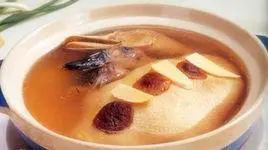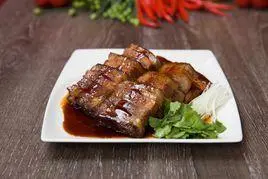- GaoYou Lake Hairy Crab
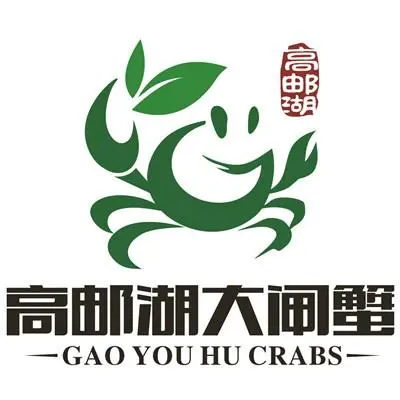
- Ingredients & Cooking Method: This dish predominantly uses female crabs from GaoYou Lake, chosen for their purple shells and rich yolk. After being marinated in wine, they’re often accompanied by tender waterweed and young ginger shoots in bottles.
- Taste & Texture: The crab offers succulent meat with its roe being rich and delicate. The overall taste is fresh with a slightly sweet undertone, and the consistency is juicy.
- Cultural Significance: GaoYou Lake Hairy Crab’s fame can be traced back to the Northern Song Dynasty. As one of the specialties of GaoYou, it holds profound cultural importance, encapsulating the local flavors and traditions.
- Popularity: Designated as a product under national geographical protection, it’s celebrated as one of the pinnacle crab delicacies in China, attracting numerous gourmets.
- Da Zhu Gan Si (Dried Tofu Strips)
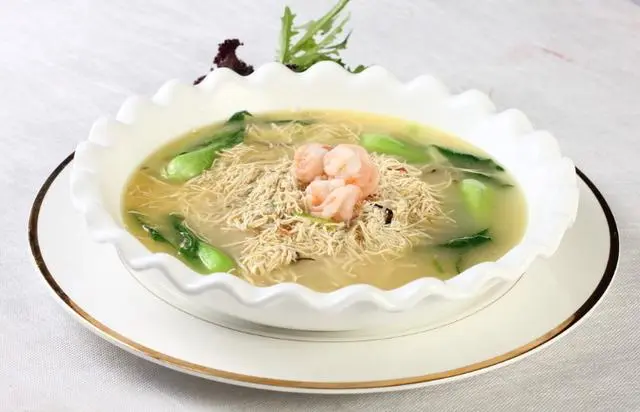
- Ingredients & Cooking Method: The centerpiece of this dish is tofu strips from the Huaiyang region. These are meticulously sliced and then infused with various seasonings.
- Taste & Texture: The dish is refreshing and nutrient-rich. The tofu strips, soaked in aromatic seasonings, strike a balance between tenderness and chewiness.
- Cultural Significance: This is an iconic dish within the Huaiyang culinary tradition, representing the locality’s distinct culinary artistry.
- Popularity: As one of Huaiyang cuisine’s hallmark dishes, it enjoys widespread acclaim.
- Crab Powder Lion’s Head (meatballs)
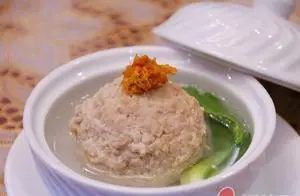
- Ingredients & Cooking Method: These meatballs integrate crab meat with finely chopped pork. Depending on the preparation, they can be braised, steamed, or stewed.
- Taste & Texture: The texture is soft, rich, but not excessively greasy, providing a luxurious mouthfeel.
- Cultural Significance: A traditional delicacy of Yangzhou, Jiangsu, it mirrors the unique flavors and cultural heritage of Huaiyang cuisine.
- Popularity: Renowned for its rich flavor and aesthetic appeal, it stands as a symbol of Yangzhou’s culinary prowess.
- Wen Si Tofu
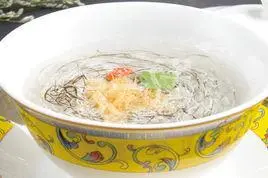
- Ingredients & Cooking Method: Hailing from Jiangsu, this dish uses specially chosen tofu, meticulously processed to ensure it dissolves instantly when tasted.
- Taste & Texture: Exceptionally tender, it offers a soothing, velvety experience with a subtle aromatic charm.
- Cultural Significance: A time-honored dish from Jiangsu, it epitomizes the region’s rich culinary heritage and exemplifies the artistry inherent in its food culture.
- Popularity: Widely celebrated in Jiangsu and throughout China.
5. Chai Hui Lian Yu Tou (Braised Silver Carp Head):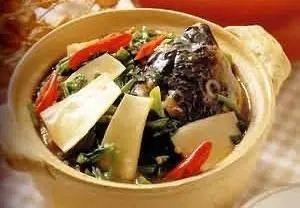
- Main Ingredients & Cooking Method: A renowned traditional dish from Jiangsu, belonging to the Jiangsu cuisine. The primary ingredient is the silver carp head, prepared using braising techniques. During its preparation, the fish head is skillfully deboned, then braised with appropriate seasonings to fully extract and amplify its taste and nutrients.
- Taste & Texture: This dish has a savory, salty taste. Its unique texture includes sticky, tender skin and succulent, juicy flesh. The broth is thick and flavorful, and when consumed, one can savor the delicate meat and richness of the fish, complemented by the broth’s intense flavor.
- Cultural Significance: As a traditional dish of Jiangsu, it carries profound cultural significance. It embodies the culinary expertise of Jiangsu in fish preparation and the value they place on ingredients. In Chinese culture, the silver carp head is symbolically rich, representing prosperity and good fortune. Hence, this dish often appears at significant banquets and festivals, symbolizing people’s aspirations and blessings for a good life.
- Popularity & Influence: As a traditional dish from Jiangsu, it has significant recognition and influence. Esteemed and adored both in Jiangsu and nationwide, it stands as one of the representatives of Jiangsu cuisine. Its rich flavor and unique preparation method captivate many gourmets and food enthusiasts.
- Main Ingredients & Cooking Method: San Tao Ya is a traditional dish from Yangzhou and Gaoyou regions of Jiangsu. It predominantly uses Gaoyou duck, known for its succulent meat, making it an ideal ingredient for various duck dishes. Typically, it’s roasted after appropriate processing and seasoning, bringing out its distinctive taste and texture.
- Taste & Texture: San Tao Ya boasts a rich and delectable taste. The Gaoyou duck meat is tender, and when roasted, it results in crispy skin and juicy meat. Paired with specially crafted seasonings and spices, its flavor becomes even more profound. When consumed, one can appreciate the crispy skin, succulent meat, and the aromatic infusion from the spices.
- Cultural Significance: Representing the culinary heritage of Yangzhou and Gaoyou, this dish holds deep cultural value. It reflects the local gastronomic expertise with duck meat and the appreciation of ingredients. Gaoyou duck holds a vital status in the local area, making San Tao Ya an emblematic dish representing local culinary traditions.
- Popularity & Influence: As a traditional dish from the Jiangsu region, San Tao Ya enjoys significant recognition and influence, especially in Yangzhou and Gaoyou. It stands as a testament to the local food culture and has captivated many food lovers with its unique roasting technique and delightful taste.
7. Ba Shao Zheng Zhu Tou (Grilled Whole Pig’s Head):
- Main Ingredients & Cooking Method: This traditional dish from Jiangsu employs a fresh pig’s head. After removing the bones and hair, the head is split open, cleaned, and seasoned with soy sauce, salt, and rock sugar. It’s then cooked until the meat is tender and flavorful but not excessively greasy.
- Taste & Texture: Offering a sweet and salty flavor, the dish ensures the meat is perfectly tender. It’s rich in taste, with a soft, melt-in-the-mouth texture, delivering both gustatory satisfaction and a delightful olfactory experience.
- Cultural Significance: Originating from the cooking methods of Northern Chinese farmers, this dish has evolved into a significant traditional dish in Jiangsu. It highlights the unique utilization of the pig’s head, showcasing respect for ingredients and culinary heritage. It also stands as a representation of Jiangsu’s food culture, rich in local flavors and cultural significance.
- Popularity & Influence: As a traditional dish of Jiangsu, it holds a prominent position locally, deeply loved and admired. Its unique taste and preparation method have drawn the attention of many food enthusiasts, positively impacting Jiangsu’s food culture and promoting the legacy and evolution of local dishes.
8. Jiang Jun Guo Qiao (General Crossing the Bridge):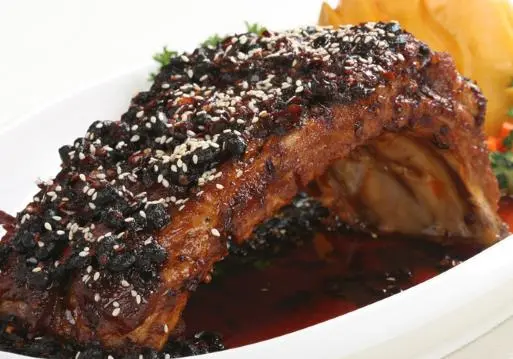
- Main Ingredients & Cooking Method: A traditional dish from Yangzhou, Jiangsu, belonging to Su cuisine. The main ingredients include fish slices, fish broth, and various side dishes like eggs, shrimp, and tofu. During cooking, fish slices are boiled in hot fish broth and then combined with the other ingredients, ensuring the dish remains piping hot.
- Taste & Texture: The fish slices of Jiang Jun Guo Qiao are pure white and silky smooth. The broth is milky white, offering a savory, slightly chewy taste. The dish’s texture is smooth and delicate, with a rich and delightful broth.
- Cultural Significance: This dish, as a traditional staple of Yangzhou, represents a part of its food culture. The name derives from a legend where a general traveled far from home, and his wife would bring hot soup and ingredients to him, ensuring the dish remained warm. Symbolizing family reunion and care, it carries profound cultural meanings.
- Popularity & Influence: As a traditional dish of Yangzhou, Jiangsu, it enjoys significant recognition and influence locally. It’s a testament to Yangzhou’s culinary expertise, and its unique taste and meticulous preparation captivate many.
- Main Ingredients & Cooking Method: Kao Fang is a traditional dish from Yangzhou, dating back to the Qing Dynasty. Using white spring onion as its primary ingredient, it’s prepared with rib meat from small winter pigs from Northern Jiangsu. The dish is distinctively roasted without any added seasoning, emphasizing mastery over the flame.
- Taste & Texture: Kao Fang is renowned for its extraordinarily crispy outer layer and tender, aromatic meat within. The dish is visually appealing, with a unique cooking method that is truly unparalleled.
- Cultural Significance: As a traditional dish from Yangzhou, Kao Fang possesses a rich history and deep cultural roots. It’s a favored dish among Yangzhou’s officials and salt merchants when hosting guests, reflecting the importance of banquet culture and culinary pursuits in the local area.
- Popularity & Influence: As a staple of Yangzhou, Kao Fang holds high regard locally, being an integral part of the region’s culinary culture. Its unique taste and sophisticated cooking techniques have drawn many admirers, further promoting the development and legacy of Jiangsu cuisine.
10. Ya Bao Yu Chi (Duck Wrapped Shark’s Fin):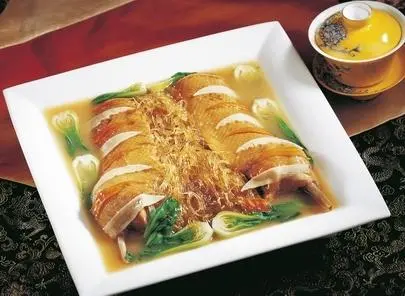
- Main Ingredients & Cooking Method: Ya Bao Yu Chi is a traditional dish from Yangzhou, Jiangsu, belonging to the Yangzhou cuisine lineage. Its main ingredients comprise duck meat and shark’s fin. During its preparation, it’s typically cooked in combination with meats, chicken, duck, and shrimp, aiming to complement protein sources and amplify the dish’s umami taste. The cooking methods for Ya Bao Yu Chi are diverse, including techniques like stewing, boiling, and roasting.
- Taste & Texture: The broth of Ya Bao Yu Chi is flavorful and rich, with tender meat offering a profound taste. Shark’s fin is collagen-rich, harmoniously merging with the other ingredients to grant the dish a tender mouthfeel. The overall taste is sweet with a hint of saltiness, balanced and harmonious. It’s known for its beneficial properties, such as invigorating qi, draining dampness, stimulating appetite, and nourishing the skin.
- Cultural Significance: Ya Bao Yu Chi, as a traditional Yangzhou dish, holds rich cultural values. It embodies the unique culinary aspirations of Yangzhou’s residents and their focus on health and wellness. As an exquisite banquet dish, Ya Bao Yu Chi conveys people’s yearnings for a beautiful life and joyous reunions.
- Popularity & Influence: Being a traditional dish from Yangzhou, Jiangsu, Ya Bao Yu Chi enjoys significant recognition and influence locally. It stands as a testament to the culinary standards and unique flavors of Yangzhou cuisine, and is widely favored by diners. The dish’s delectable taste and nutritional value have been widely propagated and esteemed, making a significant contribution to the evolution and promotion of Yangzhou’s culinary culture.
